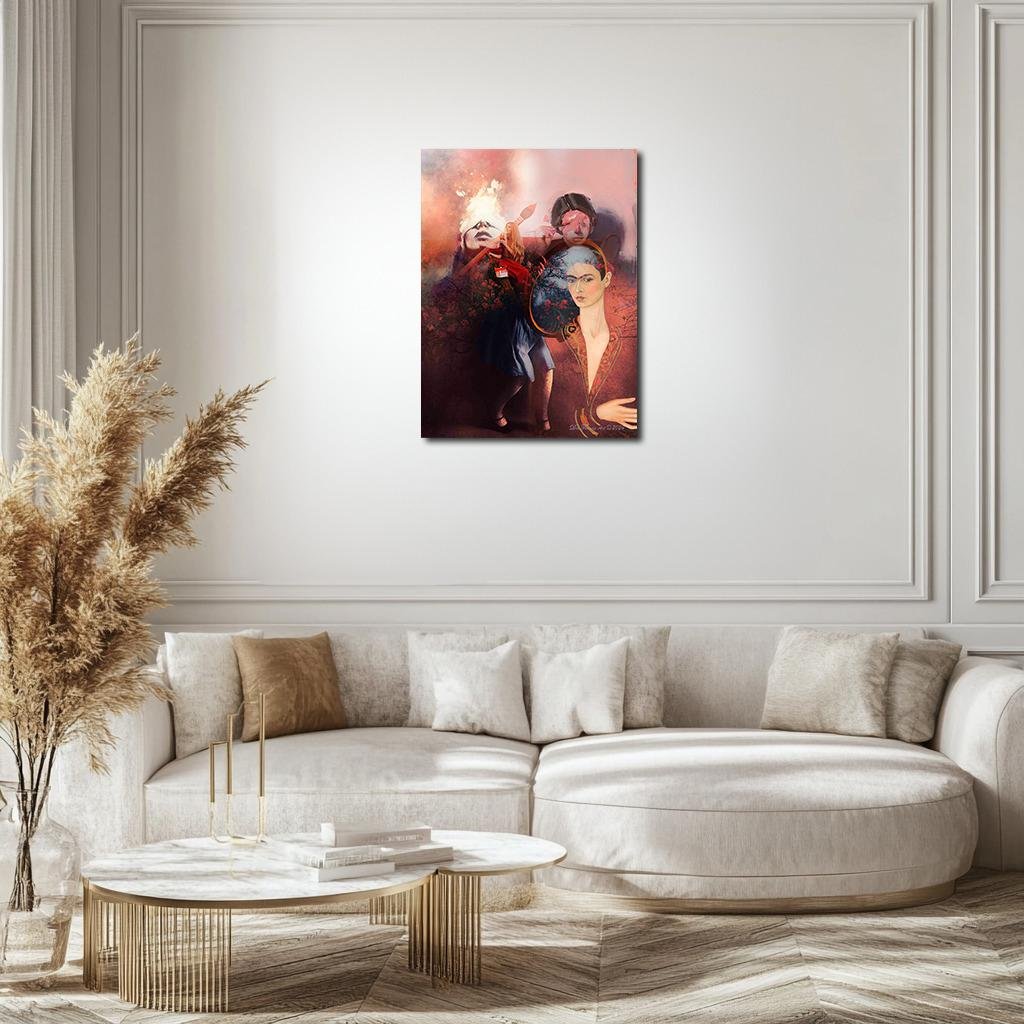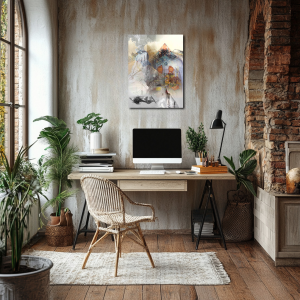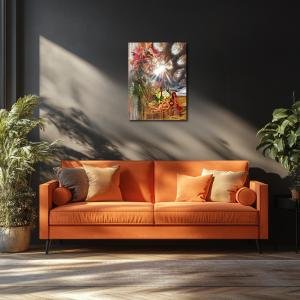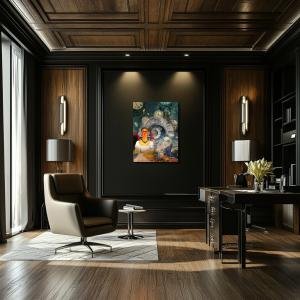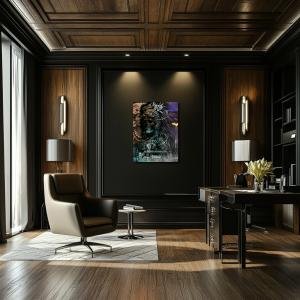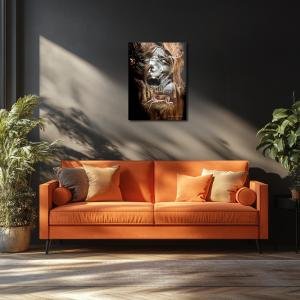The First Mirror: Frida’s Velvet Awakening
The First Mirror reimagines Frida Kahlo’s Self-Portrait in a Velvet Dress as a surreal threshold between reflection and emergence. With velvet reds, gold filigree, rose-blood branches, and glowing ivory, the piece traces Kahlo’s early act of self-creation as a profound gesture of authorship. Surrounded by ghosted figures and burning visions, her image becomes the center of a dreamlike orbit, where artist and muse are born together in one steady, defiant gaze.
Please see Below for Details…
Hotline Order:
Mon - Fri: 07AM - 06PM
404-872-4663
This conceptual reimagining of Frida Kahlo’s Self-Portrait in a Velvet Dress translates her youthful assertion of identity into a layered vision of reflection, transformation, and creative awakening. Titled The First Mirror , the work expands Kahlo’s early act of self-depiction into a surreal tableau where the boundary between artist and subject dissolves. The result is not merely a portrait of how she looked, but a visual hymn to the moment when she first saw herself as creator, muse, and mythmaker.
At the heart of the piece, Kahlo’s elongated neck and aristocratic posture echo the original portrait’s nod to Renaissance elegance and Botticellian grace. Her skin, pale and pristine, gleams with the cool self-awareness of youth newly awakened to its own symbolic power. She gazes not into a mirror but out of one, the oval frame encircling her not as confinement, but as a luminous threshold between inner world and outer gaze.
Around her, the world bends with symbolic transformation. To her left, a faceless figure paints blindly—a torch of light erupting from their head, suggesting the blinding urgency of artistic compulsion. A woman with a brush ascends a ladder of roses, her red coat echoing the hues of Frida’s own heart—a reflection of the painter’s journey from invisibility into creative self-possession. Another ghostly figure hovers behind, holding her own painted mask like a question, as if unsure whether she is removing it or applying it for the first time.
The background blooms into a garden of contradictions—roses and thorns, dusk and flame, all enmeshed in tangled branches that cradle and ensnare. This is not the neat setting of youth’s clarity, but the chaotic garden of becoming, where identity sprouts through pain, ego, desire, and fragile hope.
The color palette of The First Mirror speaks in layered whispers and sudden declarations. Frida’s skin is rendered in luminous ivory and soft blush, untouched by time or injury, evoking her own search for purity and artistic control in her first attempts to define herself. The velvet dress, translated into deep oxblood red with curling accents of gold, stands as a bold gesture of refinement—an external assertion of worth before it was ever given to her by others.
Surrounding the portrait, the hues darken and bloom: earthy burgundies, smoky indigos, and burnt sienna roses swirl through the background. These colors speak of rich soil, inner wounds, and the feverish ground where selfhood is born. There is no harsh contrast—only flowing transitions from light to shadow, from stillness to motion, mimicking the way memory and perception shift as one looks inward.
The ghosted artist in the upper left is awash in creams and firelight, her head a candle in a storm, suggesting that every creator must first lose themselves in vision before bringing clarity to form. The painter climbing into the frame is dressed in crimson and steel blue—colors of passion and structure, struggle and elevation. Her presence acts as a metaphor for Frida’s own emergence, both literally and psychologically, into the act of self-creation.
The lower half of the piece is tinged with muted violets and warm rust, suggesting the subtle gravity of self-consciousness, of learning to carry one’s image as both burden and offering. It is not simply vanity being painted here, but declaration—the sacred weight of being seen, and of deciding what that seeing will mean.
When I created The First Mirror , I wanted to reflect not just the iconic imagery of Kahlo’s early work, but the quiet, courageous act it represented: to paint oneself not as one is told to be, but as one feels within the private garden of the soul. In her original Self-Portrait in a Velvet Dress , Kahlo posed with classical beauty, but beneath that elegance was an urgent need—to mark her presence, to begin the lifelong excavation of identity, pain, and power through art. This reimagining lifts that moment into the surreal: the instant she crossed the threshold into herself as creator and myth.
The composition spirals gently from the top left, where the painter’s flame ignites, down through the blooming branches and across to the gaze of Kahlo herself. From there, the viewer is drawn back into the outer figures—specters of potential futures, the selves she will become, leave behind, or absorb into her work. There is no hierarchy, only orbit—each element turning around the unshakable center of Kahlo’s gaze.
In this vision, Frida Kahlo is both the mirror and the reflected, the muse and the master of her image. She does not simply pose; she claims. This is the beginning—not of fame, not of pain, but of authorship. This is the first mirror, held not to reflect beauty, but to summon the self.
Add your review
Your email address will not be published. Required fields are marked *
Please login to write review!
Looks like there are no reviews yet.

